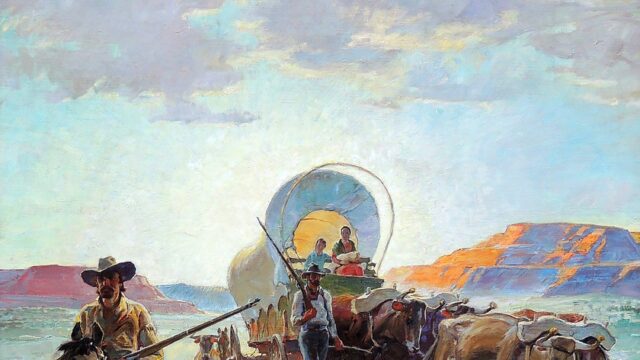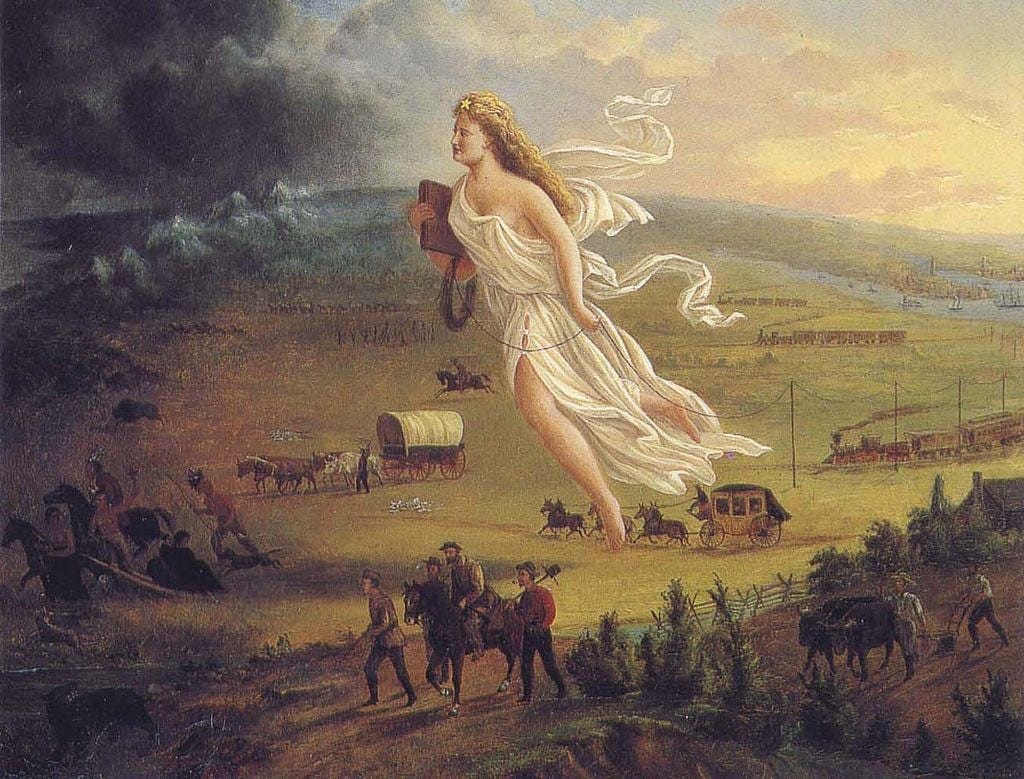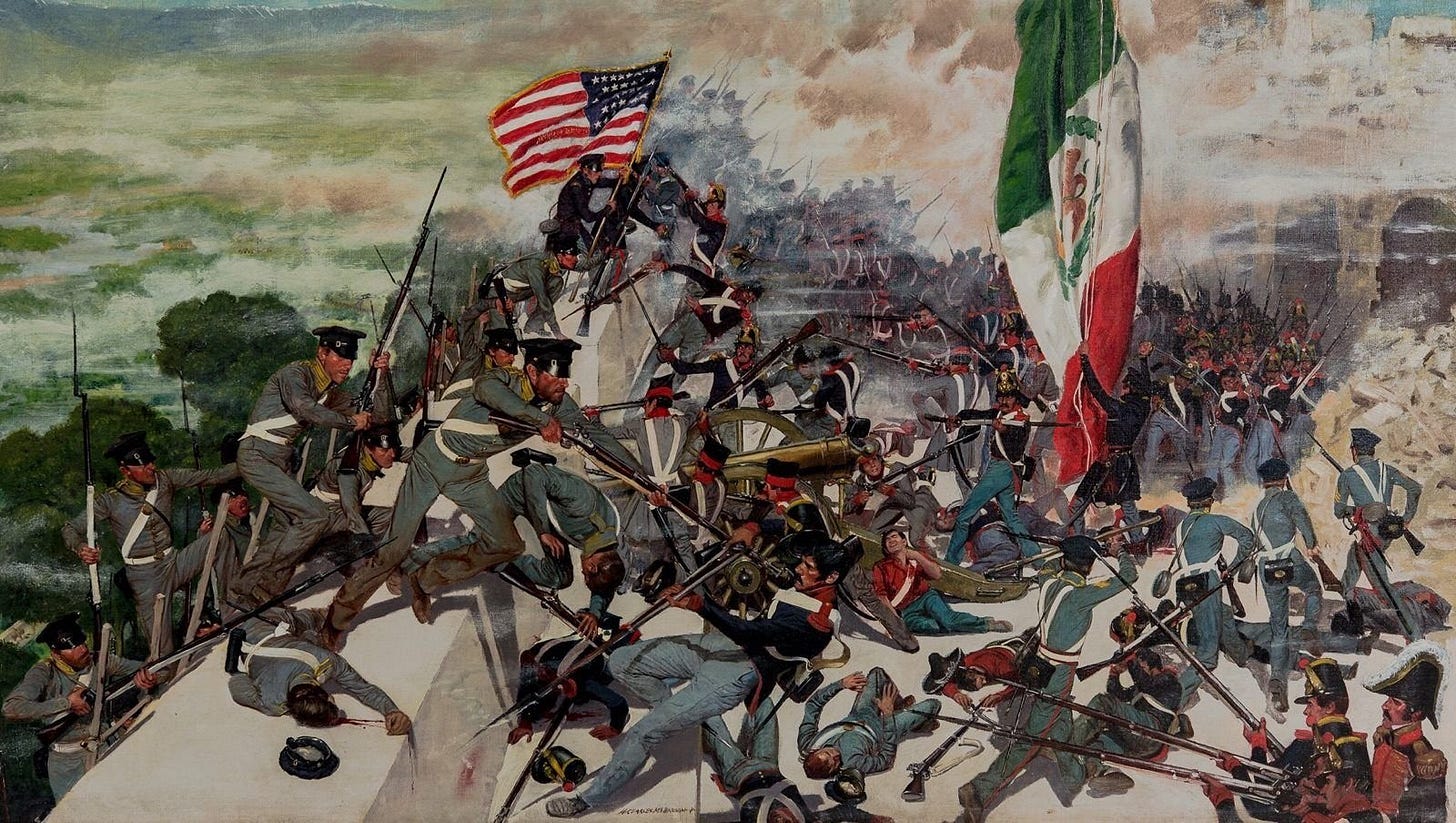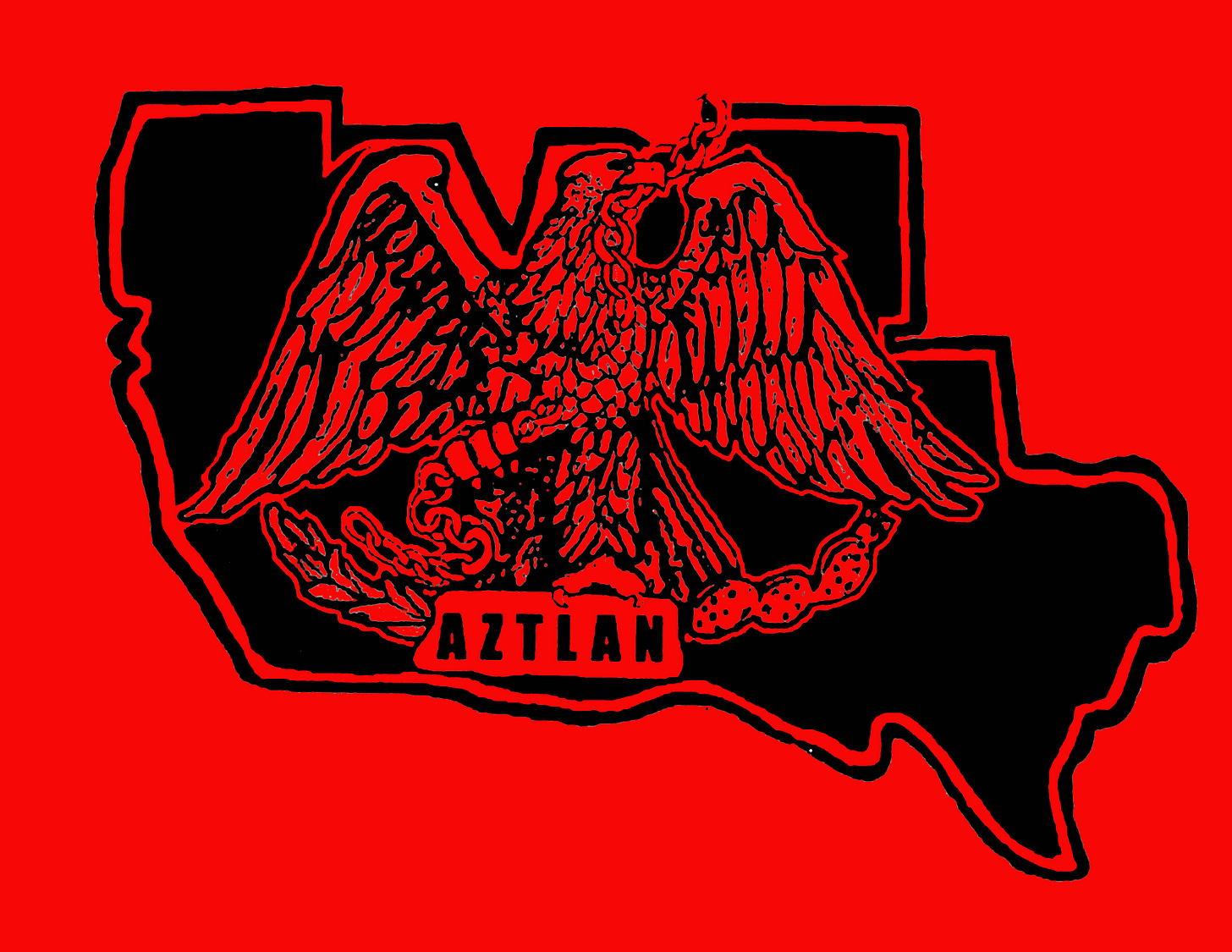Mexico and the Myth of Stolen Land

The notion that California, and by extension the entirety of the American Southwest, was “stolen” from Mexico has been repeated with such frequency and moral certainty that in many quarters it now passes for established historical fact.
This, of course, is no accident. In the modern West, history is no longer treated as the solemn record of a people’s trials and triumphs—as something meant to instruct, to ground identity, and to carry meaning across generations. It has been reduced to a pliant script, endlessly revised to satisfy the ideological demands of an ever-triumphant present, one animated by the “current thing” and by a Regime that feeds on demographic upheaval, historical erasure, and the ritualized inversion of truth.
The “stolen land” narrative now functions as one of the principal justifications for the demographic transformation of the United States. Cloaked in the rhetoric of Reconquista, it recasts demographic usurpation as a belated act of ancestral redemption. It is presented not as conquest, but as return—as if the systematic replacement of White Americans were not a calculated policy, but the correction of some primordial imbalance. Stripped of its sentimental veneer, the myth disintegrates. It is not a record of history, but a ritual of inversion—turning defeat into grievance, and inheritance into guilt, to sanctify what no civilization should accept.
As such, and not at all surprisingly, the disorder now overtaking Los Angeles is no spontaneous aberration conjured from the ether, but the direct consequence of decades of calculated demographic engineering and ideological decay. It is the visible cost of a falsehood repeated until it ossified into official doctrine. Beneath the strata of manufactured slogans and theatrical appeals to moral sentiment lies a deeper struggle—one not merely over policy, but over identity, sovereignty, and historical memory. It is a contest in which myth displaces record, in which invented lineage supplants lawful inheritance, and in which capitulation is rebranded as justice. The public is told that California is merely reverting to its rightful owners, that unchecked migration and the demographic erasure of White Americans constitute a long-overdue moral restitution. Yet the contrived historical narrative that sustains this reckoning collapses under serious inquiry, for it cannot withstand the standards of law, legacy, or ethnocultural authorship.

California was never Mexican in any meaningful civilizational or ethnonational sense. It existed as a peripheral holding of the Spanish Empire, a distant and neglected frontier governed less by law than by the limitations of geography. A sparse network of missions, presidios, and tenuous coastal settlements took shape in the late eighteenth century, but the interior remained tribal, unincorporated, and largely untouched. With the declaration of Mexican independence in 1821, California passed to the nascent republic not through conquest or development, but by default; it inherited the province as a squatter inherits a crumbling estate—by assumption rather than merit, and without the capacity to develop or defend it. What ensued was not administration, but drift. Governance was nominal, the population remained scant, and the territory languished in underdevelopment. As in other neglected provinces such as Spanish Florida and Nuevo Santander (in present-day northeastern Mexico and southern Texas), it was only with the arrival of White Americans that this untapped land was drawn into the orbit of a functioning civilization.
From 1821 to 1846, Mexico nominally held Alta California—the northernmost province of New Spain, encompassing most of present-day California—though its authority remained tenuous at best. While its legal claim persisted until the Treaty of Guadalupe Hidalgo in 1848, real governance was scarcely exercised. The early republican period was defined by inertia and confusion; administrative control initially remained in the hands of officials appointed under the Spanish regime. Not until 1823 did Mexico begin appointing its own governors, yet even then, authority was more symbolic than sovereign, more ceremonial than real. This pattern mirrored developments across Mexico’s northern frontier, where distance from the capital, weak infrastructure, and constant internal upheaval prevented the consolidation of state power. In Alta California, as elsewhere, sovereignty was declared but never truly imposed.
Throughout this period, Alta California remained a distant and neglected frontier, sparsely populated and culturally estranged from the principal institutions of Mexican life. A narrow class of Californio elites, nominally loyal to Mexico but descended from European Spanish settlers, presided over vast ranchos and governed with near-total autonomy. These estates formed no part of a coherent national structure; they were isolated dominions, tenuously connected to a Mexico City already beset by successive coups, internal strife, and foreign incursions. Though the Californios exercised local authority, their rule was feudal in character, anchored in landholding and family prestige rather than in institutional support or national integration. Authority in the region was weak, inconsistent, and often absent. Rebellions erupted with regularity, and the Mexican government, lacking both the means and the resolve, proved incapable of reasserting control.
In an effort to populate the region and reinforce its tenuous claims, the Mexican government began issuing land grants to Anglo-American settlers during the 1830s. These settlers arrived bearing the hallmarks of the Anglo-American tradition: legal order, permanence, and the capacity for self-government—qualities rooted in the dual legacies of Puritan “ordered liberty” and Virginian “hegemonic liberty,” as described in David Hackett Fischer’s Albion’s Seed. Descended from those who had governed communal townships in New England and established expansive territorial dominions in the South, they brought with them a civilizational ethic shaped by centuries of legal tradition, inherited authority, and decentralized governance. The institutional frameworks they introduced on the frontier would later provide the constitutional scaffolding for California’s integration into the American republic. Under the empresario system, figures such as Stephen F. Austin oversaw the organized settlement of vast tracts, introducing the rudiments of legal administration, private property, and institutional coherence. Their numbers expanded rapidly, as did the material infrastructure and political framework that would come to define American California. Racial and cultural frictions intensified, while the Mexican authorities, fragmented and ineffectual, proved unable to arrest the drift. The northern frontier continued to recede from its putative center, inching steadily toward an inevitable transfer of sovereignty.
At the very moment Mexico asserted sovereignty over California, its state apparatus was already disintegrating. The decades following independence were characterized by chronic instability; between the 1830s and 1840s, the country cycled through presidencies with astonishing rapidity, suffered repeated military coups, and was beset by endemic lawlessness across its provinces. Central authority, never robust to begin with, deteriorated to the point of near-total collapse, and the northern frontier, remote from the capital and devoid of strategic investment, was abandoned to inertia. As in California, the Mexican government had sought to stabilize Texas through the importation of Anglo-American settlers, hoping to use them as a buffer against Comanche depredations. This measure, born of weakness rather than foresight, laid the groundwork for rebellion. These settlers, having introduced a degree of order and permanence absent under Mexican rule, soon came into conflict with a regime they neither respected nor feared. The confrontation reached its dramatic apogee at the Alamo in 1836, where a small garrison of American volunteers fell before superior Mexican forces. Though the battle was a tactical defeat, it became a symbol of resistance and galvanized the Texian cause; within the year, the Republic of Texas proclaimed its independence.

By 1846, conditions along the northern frontier had reached a breaking point. The Mexican–American War (1846–1848) did not arise solely from American expansionism, nor was it merely a byproduct of Manifest Destiny, as is often claimed. It arose from the chronic failure of the Mexican state to secure and administer its own periphery. In the contested expanse between the Nueces River and the Rio Grande—territory claimed by both nations following the annexation of Texas—Mexican cavalry launched an armed assault against a small detachment of American dragoons under Captain Seth Thornton. This engagement, later known as the Thornton Affair, constituted a deliberate act of aggression, carried out before the United States had formally declared war. The conflict that followed was not merely a campaign of conquest; it was the predictable outcome of a collapsed frontier policy, a disintegrating central government, and the inability of Mexico to project sovereignty over its claimed domain.
The American response was swift, decisive, and strategically coordinated. Within months of the declaration of war, United States forces had secured the northern frontier, establishing effective control over New Mexico and Alta California with minimal resistance. From these initial gains, American troops launched a two-pronged campaign: General Zachary Taylor advanced from the north through the heart of northern Mexico, while General Winfield Scott undertook an amphibious landing at Veracruz and pressed inland toward the capital. Despite determined resistance at key engagements—Palo Alto, Resaca de la Palma, Buena Vista, Cerro Gordo, and Chapultepec—the Mexican army, hampered by political instability, poor logistics, and a fractured command structure, proved unable to halt the advance. By September 1847, American forces had entered Mexico City, securing not only military victory but symbolic dominance over the entire theater of war.
The conflict formally concluded with the Treaty of Guadalupe Hidalgo in 1848. Under the terms of the treaty, Mexico ceded nearly five hundred and twenty-five thousand square miles of territory, including present-day California, Nevada, Utah, and large portions of Arizona, New Mexico, Colorado, and Wyoming. In exchange, the United States paid fifteen million dollars and assumed certain claims held by American citizens against the Mexican government. By the standards of the time, this was a considerable sum. The acquisition was neither wanton plunder nor capricious annexation, but conquest ratified by diplomacy and made lawful through treaty, in accordance with the principles of ius gentium, the traditional law of nations that governed the conduct of war and the transfer of territory. These lands, long neglected and poorly governed, were incorporated into the American republic not merely through arms, but through settlement, administration, and the steady advance of a higher civilizational order.

Since that day, California has remained in American hands for over one hundred seventy-five years, a tenure that far exceeds the brief and ineffectual period of nominal Mexican rule. In that time, it has been transformed, settled, irrigated, governed, and defended not by the remnants of Spanish colonialism or the faltering hand of Mexican republicanism, but by Americans who imposed order, built institutions, and raised the infrastructure of a modern civilization. From the 1849 Gold Rush to the Pacific Railway Acts, from the construction of transcontinental routes to the harnessing of the Sierra Nevada watershed, the state became a symbol of national ambition and technological mastery. The roads, railways, aqueducts, cities, ports, and legal frameworks that render the region habitable and prosperous are not the inheritance of Mexican stewardship, but the product of American will and labor. San Francisco did not rise from the marshes by edict of Mexico City. Los Angeles was not carved into a metropolis by absentee governors or Californio rancheros. The deserts were not electrified, nor the rivers dammed, by a regime that could scarcely hold its own capital. It was White Americans who transformed the region, California and indeed the broader American Southwest, into one of the most advanced and productive civilizational zones in world history.
While this essay centers on California, particularly in light of the chaos now unfolding in the streets of Los Angeles, its argument extends to the entire American Southwest. The same historical myths, the same demographic pressures, and the same unraveling of civilizational order are evident across Texas, Arizona, New Mexico, and beyond. The historical record and the moral reality remain unchanged. These territories were not stolen; they were conquered, settled, and built by White Americans. They are now being lost not through the march of foreign armies, but through demographic warfare, a campaign of replacement waged in silence, with the full complicity of the Regime.
And yet today, under the guise of redress and restitution, the gradual erosion of American sovereignty is consecrated as a moral imperative. Mexican nationalists, Chicano ideologues, and their globalist patrons advance a vision of Reconquista carried out not through military engagement or legitimate diplomacy, but through demographic pressure and bureaucratic accommodation. What was once the product of conquest and treaty is now reimagined as an historical injustice to be rectified by numbers alone. This interpretation, veiled in the language of ancestral right, rests upon a fundamental distortion of political legitimacy and historical continuity. It draws not from law, precedent, or civilizational achievement, but from grievance, sentiment, and an ideological mythology crafted to rationalize the dispossession of White Americans.

The intellectual architecture of this revisionism can be traced to the radical currents of the mid-twentieth century, particularly the emergence of El Plan de Aztlán in 1969, a “Chicano nationalist” manifesto that called for the educational, economic, racial, and separatist self-determination of Mexicans in the United States. Alongside it arose organizations such as MEChA (Movimiento Estudiantil Chicano de Aztlán), which articulated a vision of the Southwest not as the fruit of American statecraft and expansion, but as a colonial occupation awaiting reversal. Within this framework, the foundational achievements of White governance—legal order, territorial development, public infrastructure, and economic vitality—are not regarded as marks of civilizational authorship, but are dismissed instead as illegitimate impositions upon a supposedly dormant indigenous sovereignty. Such arguments are not historical; they are theological, grounded in mythic claims to land and identity that, when subjected to serious scrutiny, fail to meet the standards of political continuity or ethnocultural legitimacy.
This is not the natural circulation of peoples across porous borders, nor a benign migration in the classical sense. It is a calculated and state-sanctioned act of demographic colonization. The Mexican government, long incapable of sustaining its population or fostering coherent development, has embraced the export of its underclass as a de facto strategy of national relief. The American Regime, no longer tethered to the preservation of its founding race, accepts this influx not to strengthen the polity, but to reshape it. The question is not labor or culture, but replacement. A sovereign White population, rooted in the land through memory, inheritance, and sacrifice, is gradually supplanted by a servile caste, estranged in blood, history, and spirit from the civilization it enters. This is not immigration in the service of a republic, but the substitution of one people for another—the calculated displacement of a race once capable of sustaining the moral, civic, and institutional conditions of republican liberty. What proceeds is not war, nor revolution, but dissolution.
This is colonization reversed: not the imposition of civilization upon wilderness, but the slow encroachment of disorder upon the remnants of a once-ordered world. It is the very charge once falsely leveled against the American settler, now reenacted in earnest under the sanction of the modern Regime. The irony could scarcely be more complete. These new colonizers do not arrive with vision, discipline, or the burden of creation. They come to inhabit what others have built, to draw from reservoirs of generational wealth, inherited order, and legal tradition which they neither conceived nor are capable of sustaining. There is no renaissance of Aztlan, no revival of ancestral forms, no vision of polity or cultural restoration. There is only the parasitic attrition of institutions that continue to function in spite of their contempt. Access to White people is now treated as a “human right,” as if mere proximity to the authors of order were itself a source of nourishment. They do not seek to build, to cultivate, or to redeem. They come to extract, to dwell within structures fashioned by White labor and genius, and to drag them downward, slowly and inexorably, into the very dysfunction they once fled.

No part of the United States belongs to Mexico. Not by right of history, not by force of arms, and not by the legacy of its people. The belief that it does endures only because Americans have been taught to forget who they are, and to despise what their ancestors built. California and the territories of the Southwest were not “stolen” or “unjustly taken.” They were conquered, settled, and made American through the blood, sweat, and sacrifice of our forefathers.
The United States is not a random expanse of land, nor a marketplace defined by borders on paper. It is a people, bound by memory, by inheritance, by kinship, and by the civilizational will to endure. It is the blood-earned patrimony of the White settlers who carved order from frontier, raised cities from wilderness, and planted their flag not as trespassers but as founders. A nation that will not defend its borders will not long possess them. And a people that forgets the cost of conquest will forfeit both the land and the right to dwell upon it. In the end, memory alone is not enough. Survival belongs to those who remember and act.
https://chadcrowley.substack.com/p/mexico-and-the-myth-of-stolen-land
